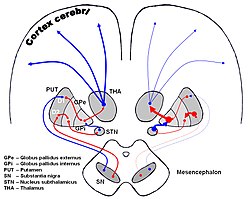| Thalamic fasciculus | |
|---|---|
 The image shows dopaminergic pathways of the human brain in normal condition (left) and Parkinsons Disease (right). Red Arrows indicate suppression of the target, blue arrows indicate stimulation of target structure. (Thalamic fasciculus visible but not labeled, as red line from GPi to THA.) | |
| Details | |
| Identifiers | |
| Latin | fasciculus thalamicus |
| NeuroNames | 439 |
| TA98 | A14.1.08.679 A14.1.09.523 |
| TA2 | 5756 |
| FMA | 62065 |
| Anatomical terms of neuroanatomy | |
The thalamic fasciculus is a component of the subthalamus (ventral thalamus). It is synonymous with field H1 of Forel. Fibers from the lenticular fasciculus (field H2 of Forel), are joined by fibers from the ansa lenticularis – different parts of the internal globus pallidus, before they enter the ventral anterior nucleus of the thalamus to form the thalamic fasciculus.[1][2] The fasciculus also contains fibers from the cerebellothalamic tract, and the pallidothalamic tract.
- ^ Estomih Mtui; Gregory Gruener (2006). Clinical Neuroanatomy and Neuroscience: With STUDENT CONSULT Online Access. Philadelphia: Saunders. p. 359. ISBN 1-4160-3445-5.
{{cite book}}: CS1 maint: multiple names: authors list (link) - ^ Haines, Duane (2018). Fundamental neuroscience for basic and clinical applications (Fifth ed.). Philadelphia, PA: Elsevier. p. 238. ISBN 9780323396325.